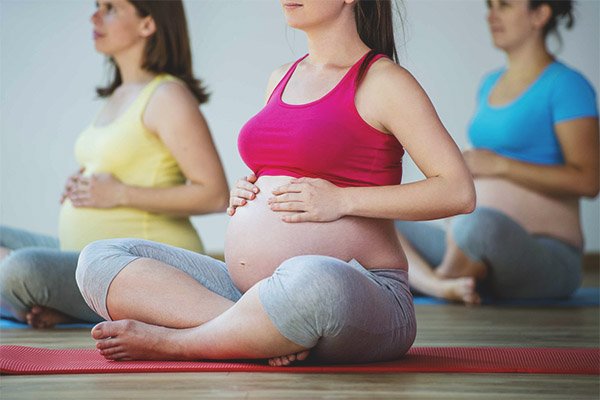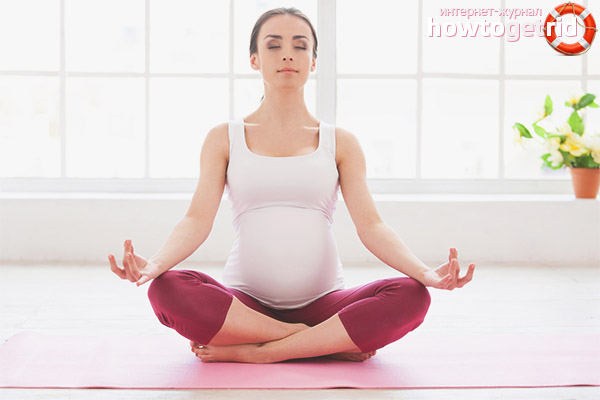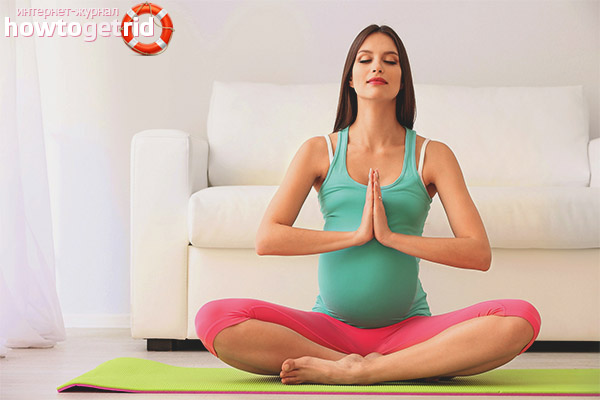The content of the article
Pregnancy can be fairly compared with walking on a tightrope. One uneven step and a person, losing balance, falls down. Only in this case, the fall "down" will not be physical, but moral. No pain stands next to the loss of a child or with the loss of his health through the fault of his mother. In order to avoid this, each expectant mother carefully measures the usefulness and harmfulness of certain moments of her own behavior during this contradictory period of her life: each product is overestimated, the loads set at work are weighed, the pros and cons of each activity that the woman preoccupied before pregnancy are measured .
Currently, yoga classes are widely recommended as a useful relaxing event for pregnant women.
What is yoga
When the word “yoga” is said out loud to any person, a thin, tanned Hindu in a turban will appear before his eyes, capable of tying his own legs in a knot, and walking on nails or fragments from broken glass. To present us with a pregnant woman in such an unexpected role is, of course, difficult. However, in recent years, when information about the techniques of yoga has gone far beyond the limits of superficial perception, it is possible to get acquainted with completely different techniques of this magnificent healing exercise. Yoga did not go around with its attention and pregnant women.
What is "yoga"? Yoga is a combination of spiritual, mental and physical practices aimed at the general strengthening of the physical and spiritual component of the human body in order to achieve a special peaceful state. It is a mistake to believe that yoga is only specially constructed physical exercises, designed to develop a particular body flexibility and require tremendous patience and endurance. In fact, the main goal of these practices is to achieve inner comfort, peace and suppression of the depressive effects of hormonal imbalance, which are observed in many women in the position.
What is the use of yoga for pregnant women
Practicing such practices during pregnancy has a beneficial effect not only on the general mental state of a woman. First of all, the complexes for the gradual stretching of the body provide invaluable assistance in the subsequent birth of the child. It is noted that yoga fans give birth faster and easier, they rarely have perineal tears, and besides, although it is difficult to associate with yoga, babies are less likely to entangle the umbilical cord of the head and neck. Recovery from this most important and responsible process is also much faster than that of ordinary women, who know about yoga only by hearsay.
What is the secret of this wonderful practice? The fundamentals of yoga (referred to in practice as “asanas”) allow a woman to maintain an active physical form, given all the limitations associated with carrying a child.
Techniques developed for women in position
Yoga for pregnant women is divided into 5 main parts:
- Superficial exercises: their strength is mainly aimed at creating an optimal blood flow to the genitals, especially to the feeding systems of the fetus (uterus, placenta), thereby enhancing the nutrition of the fetus and improving its vital functions.
- Special breathing techniques (Pranayama) that can increase the total respiratory volume, as well as correctly direct incoming oxygen through different organs and tissues, without creating a deficit in the distribution of its molecules between the mother and the fetus.
- The release of internal energy forces (posture of Mudra and Bandha): a set of specialized positions aimed at mental and physical stimulation of the normal work of the whole organism.
- Meditation is a set of techniques aimed at influencing a person’s emotions, in the process of which an individual is cleared of unnecessary, depressing thoughts and fears. In pregnant women, the most leading pathogenic feeling is the feeling of fear of childbirth (fear of death, pain, injury to the child during birth, etc.). Meditation for pregnant women is aimed at directly combating this state and at developing confidence in a positive outcome.
- Deep relaxation (yogo-sleep, also called yoga-nidra) is a complex of relaxing techniques aimed at getting rid of feelings of spasm and stiffness, characteristic of pregnant women in the last trimester.By achieving complete relaxation of the muscles and vascular organs, the woman's body opens the natural way for the outflow of accumulated moisture and, thereby, reduces the swelling characteristic of this period. In addition, the risk of developing convulsive syndromes and anxiety attacks is also significantly reduced.
The implementation of these techniques, both individually and in a single complex, perfectly prepares the body and consciousness of a pregnant woman for the upcoming childbirth:
- It increases the energy potential of the body, creates a positive attitude for the upcoming birth, highlighting the joy of the birth of the baby and putting out unnecessary fears as the main focus.
- Concentrates the attention of a pregnant woman to herself, puts the necessary emphasis on an adequate perception of what is happening and a timely response to changes in health status.
- Adapted physical exercises have a beneficial effect on the state of the muscular system, increase metabolic processes, stabilize the cardiovascular system.
- Creates a background of positive fatigue for further full sleep and quality sleep.
- Stretching exercisesthey contribute to the reduction of pain in the lumbosacral spine, which are characteristic of most pregnant women, and also qualitatively prepares the birth canal for the baby to pass (contractions are easier to bear and the perineum is less broken during labor).
- In addition to achieving the art of mental preservation of the spirit and preparing the body for childbirth, in yoga classes, many moms get to know and communicate with each other, which becomes the primary foundation for further friendship.
The average rate recommended by gynecologists for daily activities is 20 to 30 minutes. Yoga will be equally useful for both pregnant women at the initial periods, and those who stay just a few steps to the title of mother.
Methodist recommendations
No matter how useful and aesthetically beautiful yoga is, it should be understood that, above all, pregnancy. So it is necessary to observe some of the limitations that it entails. To this end, modern methodologists Yogo-technician have developed special complexes for pregnant women, taking into account the contraindications of individual moments.
- Strong twists and kinks are excluded, as in the process of their execution blood and lymphatic vessels can be pressed.
- Tilt forward at any time is excluded, as this may contribute to compression of the uterus and dizziness in a pregnant woman.
- The time of lying on the back is limited, since in the process of this a compression of the inferior vena cava occurs and, accordingly, trophic tissue of the fetus is disturbed.
- All poses "upside down" are excluded, as they can cause blood outflow from the placenta, provoke dizziness, and also cause reversal of the fetus before delivery.
- Asanas with pressure effects are excluded, since such techniques can provoke miscarriage or premature labor.
- Occupations in water with elevated temperature (from 38 ° C) are excluded, since it can cause an undesirable increase in the body temperature of a pregnant woman, and this can lead to an increase in inflammation in silent infectious foci, as well as become a provocateur of severe bleeding.
- It is not desirable to forcibly stretch the joints, which are practiced in ordinary yoga, since in this case, due to the leaching of a number of useful substances, the usual work of the joints can be disrupted.
Also during the pregnancy period, it is recommended to adhere to the old, well-known techniques regarding performance, in which the pregnant woman has confidence.It is not recommended to begin to get acquainted with yoga during pregnancy, if before her future mother had only superficial knowledge on these issues.
Who is contraindicated in yoga?
Undoubtedly, yoga techniques have a beneficial effect on the state, but, nevertheless, there are both positive and negative aspects in any aspect of the issue. Before making a decision, it is necessary to thoroughly weigh the pros and cons. What restrictions and contraindications to yoga can be identified:
- If the future mother in yoga is a beginner, then you can only perform basic, well-known in physical therapy techniques.
- It should be understood that it is not the mentor who dictates the load to the woman, but her own state - you should not strive to complete the exercise if you are experiencing any painful sensations.
- If a mother badly carries a baby, there are constant threats of miscarriage, then it is important to give up classes until the end of pregnancy.
- Caution should be addressed if babies in the womb of a mother are 2 or more.
- If there is a high water level - with sudden movements there is a risk of rupture of the amniotic fluidthe bubble.
- Classes should be discontinued if blood discharge is detected, even if it is insignificant.
- If in the history of the mother there is a threat of retinal detachment, hypertension, diseases of the joints.
Asana poses, allowed for different periods
- Full posture butterflies (Purna Titali): should extend the legs forward, connecting the feet with each other. The heels should be close to the body. You should loosen the bottom completely, then clasp your knees with your hands and move them up and down. Recommended to hold about 20 - 25 times, but you should listen to your own capabilities.
- Millstones (Chucky Chalana): performed sitting, legs stretched forward, then divorced for a short distance from each other (30 - 50 cm). Fingers should be crossed at the level of the chest, and then you should slowly touch the feet with one or the other foot. Perform this exercise carefully, as there is a risk of bending the blood vessels.
- Mountain (Tadasana): should stand up straight, arms outstretched in different directions. Raise your arms above your head, clasping your fingers, and then turn your palms upward. In this position, gradually rise to your tiptoes as high as possible.
- Half butterfly pose (Titali Asana): you should sit with your legs forward, bend the right leg at the knee and place the sole on the left thigh with a sole. Put your right hand on your left knee, and find the fingers of your bent leg with your left hand. While inhaling and exhaling, gradually lower and raise the knee.
Yoga during pregnancy is an interesting and useful occupation, primarily for complex self-knowledge. However, we should not forget that any even the most useful moment has a reverse side and it is very important not only to achieve your own balance, but also to give the child the necessary positive baggage for health, which means that everything is good for the mother.
Video: maternity yoga













To send